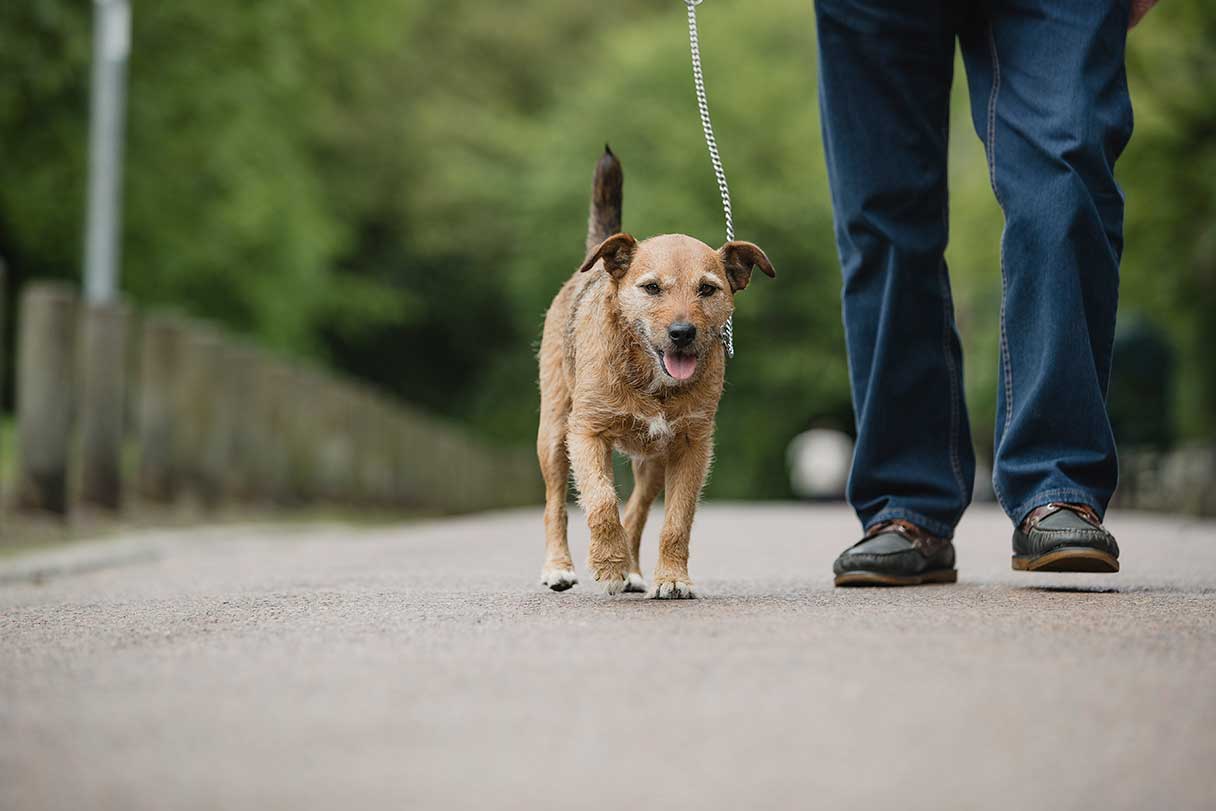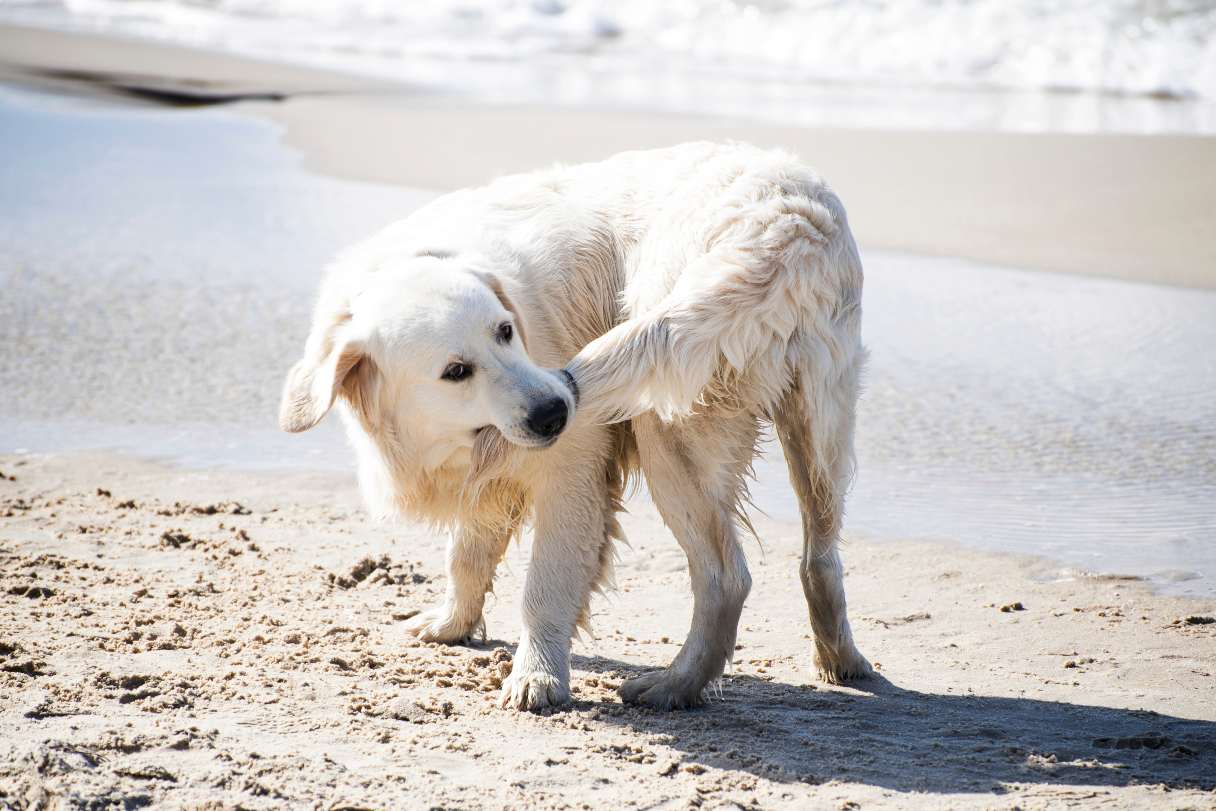Seeing your dog in pain or discomfort can be heartbreaking, especially when it comes to their mobility. If you’ve noticed your pup struggling to get up from lying down or hesitate before jumping onto the couch or into the car, it might be a sign of hip dysplasia — a common skeletal condition that affects dogs of all sizes and breeds.
Hip dysplasia can cause limping, stiffness and difficulty moving, making everyday activities challenging. While it can be complex to manage, there are many ways to support your dog’s comfort and well-being.
What Is Hip Dysplasia in Dogs?
Hip dysplasia in dogs occurs when the ball and socket of the hip joint don't fit together properly — due to genetics — causing the joint to rub and grind. As it deteriorates over time, it restricts movement and causes pain. Dogs with hip dysplasia often have a genetic predisposition for the disease, which is exacerbated by things like an excessive growth rate, being overweight and an unbalanced diet.
While hip dysplasia is often seen in larger dog breeds, it can occur in dogs of all sizes.
Signs
Symptoms of hip dysplasia change and develop over time. It can start as early as 10 to 12 weeks or develop as your dog gets older. If you notice any of the following signs, consult your veterinarian for a consultation. Some common symptoms that may indicate a dog has hip dysplasia include:
- Decreased activity level
- Decreased range of motion of the hips
- Difficulty getting up, jumping, running or climbing stairs
- Bunny hopping or swaying
- Grating in the joint when your dog is moving around
- Loss of thigh muscle mass or increase in shoulder muscle mass
- Stiffness or limping
Hip Dysplasia Diagnostic and Treatment Options
After a physical exam, your veterinarian may also recommend blood work, which will help the veterinary team get a clear picture of your pet's health. This important step ensures your pet is healthy and ready for a safe and comfortable experience with anesthesia.
The vet team may also take an X-ray to see exactly what the joint looks like. Standard X-rays usually don't reveal signs of hip dysplasia, making them less effective for diagnosis. The best way to assess hip laxity, which leads to osteoarthritis, is through a PennHIP study. This method uses a distraction index to measure how loose the hip joint is, providing a more accurate evaluation of potential issues. A lower number means tighter hips with less complications.
Once hip dysplasia is diagnosed, treatment options range from conservative management to surgical intervention. Your vet will consider your pet's age, size, activity level and the severity of joint damage to determine the best treatment plan for your pet.
Non-surgical treatments
Your vet may recommend starting with non-surgical treatments, depending on your dog’s individual condition and injury. These may include:
- Anti-inflammatory medication
- Exercise restriction
- Joint supplements or medication that helps improve the lubrication of the joint
- Physical therapy
- Weight reduction
Hip dysplasia surgery
If you and your veterinarian choose surgery as the best treatment option, it will likely be one of four types of surgery to treat hip dysplasia in dogs:
- Juvenile pubic symphysiodesis (JPS)
- Double or triple pelvic osteotomy (DPO/TPO)
- Femoral head ostectomy (FHO)
- Total hip replacement (THR)
Dog Hip Dysplasia Surgery Cost
The average cost for dog hip dysplasia surgery ranges from $800 to $10,000.1 The cost depends on the type of surgery performed, which may include:
- Juvenile pubic symphysiodesis (JPS). Dogs younger than 20 weeks with mild to moderate hip laxity may benefit from a procedure called juvenile pubic symphysiodesis (JPS). This surgery stops growth in a part of the pelvis, which helps the hip joint fit better as the dog grows. JPS works best for puppies with a specific hip laxity measurement and is most effective when done between 12 and 16 weeks of age. This highlights the need for early screening to identify dogs that may need this treatment.
- Double or triple pelvic osteotomy (DPO/TPO). This procedure, typically effective for puppies less than 10 months old, involves cutting the pelvic bone to rotate and reposition the joint for better coverage.
- Femoral head ostectomy (FHO). In an FHO, the surgeon removes the head (known as the ball) of the hip joint. This doesn’t give your dog typical hip function, but it does reduce pain.
- Total hip replacement (THR). This removes the entire joint and replaces it with metal and plastic implants. This option restores hip movement and reduces pain.
Average cost for dog hip dysplasia surgery by type
These are the average costs for the four main types of dog hip surgery available:
| Procedure | Average cost |
|---|---|
| JPS | $800 to $1,000 per hip |
| DPO/TPO | $3,000 to $6,000 per hip1 |
| FHO | $2,059 to $4,5462 |
| THR | $4,000 to $10,000 per hip1 |
Although the national average cost* for femoral head ostectomy (FHO) is $2,629, it can range from $2,059 to $4,546. This range is affected by surgery complexity, any rehabilitation needed after the procedure and clinic fees, which vary by region and seniority of the surgeon.2
Even though it’s the most expensive, THR is considered the most effective surgical treatment for hip dysplasia because the hip returns to normal functioning, and most of the discomfort and pain associated with the condition is eliminated.
Calculate the cost of femoral head ostectomy surgery near you

Explore procedure costs in your area
Average cost of hip dysplasia surgery for dogs by state/district
Here is a breakdown of the average costs* of FHO surgery in each of the 50 states and the District of Columbia:2
| State/District | Average cost |
|---|---|
| Alabama | $2,260 |
| Alaska | $3,162 |
| Arizona | $2,606 |
| Arkansas | $2,322 |
| California | $3,268 |
| Colorado | $2,587 |
| Connecticut | $2,729 |
| Delaware | $2,601 |
| District of Columbia | $3,446 |
| Florida | $2,617 |
| Georgia | $2,383 |
| Hawaii | $4,071 |
| Idaho | $2,656 |
| Illinois | $2,654 |
| Indiana | $2,330 |
| Iowa | $2,280 |
| Kansas | $2,366 |
| Kentucky | $2,391 |
| Louisiana | $2,461 |
| Maine | $2,626 |
| Maryland | $2,975 |
| Massachusetts | $3,418 |
| Michigan | $2,377 |
| Minnesota | $2,481 |
| Mississippi | $2,207 |
| Missouri | $2,283 |
| Montana | $2,564 |
| Nebraska | $2,341 |
| Nevada | $2,581 |
| New Hampshire | $2,776 |
| New Jersey | $2,933 |
| New Mexico | $2,324 |
| New York | $2,771 |
| North Carolina | $2,411 |
| North Dakota | $2,386 |
| Ohio | $2,419 |
| Oklahoma | $2,266 |
| Oregon | $2,849 |
| Pennsylvania | $2,539 |
| Rhode Island | $2,746 |
| South Carolina | $2,458 |
| South Dakota | $2,363 |
| Tennessee | $2,361 |
| Texas | $2,435 |
| Utah | $2,612 |
| Vermont | $2,857 |
| Virginia | $2,570 |
| Washington | $2,944 |
| West Virginia | $2,313 |
| Wisconsin | $2,428 |
| Wyoming | $2,397 |
Does Pet Insurance Cover Dog Hip Dysplasia Surgery?
Hip dysplasia may be covered by pet health insurance, depending on your dog’s plan and as long as they weren't diagnosed with the condition before you signed them up (preexisting conditions are typically not covered by insurance).1 It’s always a good idea to double-check your pet’s policy or call your insurance company to verify coverage before a procedure.
How Does Hip Dysplasia Surgery for Dogs Work?
Each of the four surgical options differs in procedure and recovery. Your dog will need to be under anesthesia for all of them, which may require pre-procedure blood work, exams and more.
- Juvenile pubic symphysiodesis (JPS). This procedure is aimed at puppies younger than 20 weeks with mild to moderate hip laxity. It involves surgically stopping growth in the pubic bone, which helps the hip joint fit better as the dog matures. The surgeon makes an approach to access the pelvis and then cauterizes the growth plate of the pubic bone, leading to a ventrolateral rotation of the acetabula. Ideally performed between 12 and 16 weeks of age, JPS is most effective for puppies with specific hip laxity measurements, emphasizing the importance of early screening.
- Double or triple pelvic osteotomy (DPO/TPO). These procedures involve cutting the pelvic bone in two (DPO) or three (TPO) places and rotating the segments so there is better coverage of the femoral head in the socket. It makes the hip more stable. Recent advancements require just two cuts in many cases, resulting in a less invasive surgery.
- Femoral head ostectomy (FHO). This procedure can be done on a dog of any age and is most appropriate for dogs weighing less than 70 pounds. After removing the femoral head, the body will create a false joint that relieves pain by transferring the weight from your dog’s leg to their pelvis.
- Total hip replacement (THR). THR takes about two to three hours, and your dog may need to be hospitalized for one to three days after the surgery. If your dog needs both hips replaced, your veterinarian will only do one hip at a time, with a three- to six-month healing period in between surgeries.
Possible Side Effects of Hip Dysplasia Surgery
There are always potential side effects for any procedure. Hip dysplasia surgery has some complications to be aware of, including:
- Anesthesia. Your veterinarian will likely do a presurgical exam and blood work, but puppies or dogs could still react to the anesthesia.
- Femur fracture. This can occur as a result of overexertion too soon postsurgery and is more often seen in older dogs. Physical therapy after surgery can help prevent this from happening.
- Infection. This is always a possibility after surgery, but veterinarians are extremely cautious and have many sanitary procedures in place to reduce the chance of this happening.
- Hip luxation. If your dog falls or does too much activity within the first two weeks postsurgery, the hip could pop out of its socket.
- Loosening of the joint. The joint or implant can loosen over time, especially in very active dogs.
- Patella luxation. Any joint can slip, and occasionally, a dog’s knee joint will experience patella luxation after hip dysplasia surgery.
Recovery From Hip Dysplasia Surgery
Recovery looks a little different depending on the procedure, but all require you to restrict your dog's activity for a period of time to allow healing to take place:
- Juvenile pubic symphysiodesis (JPS). This less-invasive surgery typically offers a straightforward recovery, requiring controlled activity including controlled leash walks.
- Double or triple pelvic osteotomy (DPO/TPO). Most dogs recover from this surgery in four to six weeks but will likely need physical therapy to support healing and mobility.
- Femoral head ostectomy (FHO). Your dog may have to stay in the hospital postsurgery for anywhere from a few hours to a few days. You will need to restrict your pup's activity for at least 30 days. After approximately six weeks, they can resume their regular activity.
- Total hip replacement (THR). Your pup may need to stay at the veterinarian’s office or hospital for one to three days postsurgery. The recovery period is about 12 weeks.
Hip dysplasia is a progressive condition that won’t heal on its own, and without treatment, it can become increasingly painful and limiting for your dog. The good news is that you have options — whether it’s managing their symptoms with non-surgical approaches or surgical interventions. With the right care, support and treatment plan, dogs with hip dysplasia can live long, happy and healthy lives.
Financing Hip Dysplasia Surgery With the CareCredit Credit Card
Your dog is your best friend, and you want to make sure they get the very best. That's why the CareCredit credit card is here to help you manage the costs of diagnostics and treatment for conditions like hip dysplasia.** Use our Acceptance Locator to find a veterinarian near you that accepts CareCredit. CareCredit is there for you and your pet every step of the way; continue your wellness journey by downloading the CareCredit Mobile App to manage your account, find a provider on the go and easily access the Well U blog for more great articles, podcasts and videos.
In addition to pet care, you can also use your CareCredit credit card for dentistry, cosmetic, vision, hearing, health systems, dermatology, pharmacy purchases, spa treatments and so much more within the CareCredit network. How will you invest in your health and wellness next?
Expert Reviewer
Dr. Courtney A. Campbell, D.V.M., D.A.C.V.S.-S.A.
Dr. Courtney A. Campbell is a board-certified veterinary surgeon, specializing in orthopedics, soft tissue and minimally invasive surgery. His career extends beyond the operating room; he has emerged as a media personality, infusing his work with an innovative spirit of ‘edutainment’ — a delicate fusion of entertainment and education. Dr. Campbell has shared his expertise on numerous daytime talk shows and news segments, notably as the host of "Pet Talk" on Nat Geo Wild. Today, Dr. Courtney serves as an event host, a conference speaker and a clinical instructor at the Colorado State Translational Institute. He recently founded Stitches Veterinary Surgery, the first surgical specialty hospital in Long Beach, California.
Author Bio
Abbie Mood is a freelance writer with more than 15 years of experience. She has worked with clients of all sizes to create compelling content and she has written for the American Kennel Club, Marriott Bonvoy, Women’s Health Online, Headspace and more.







